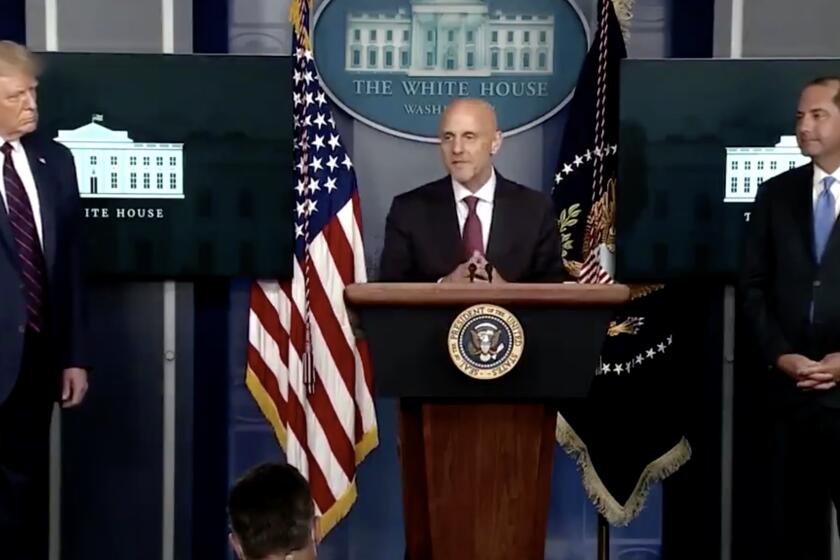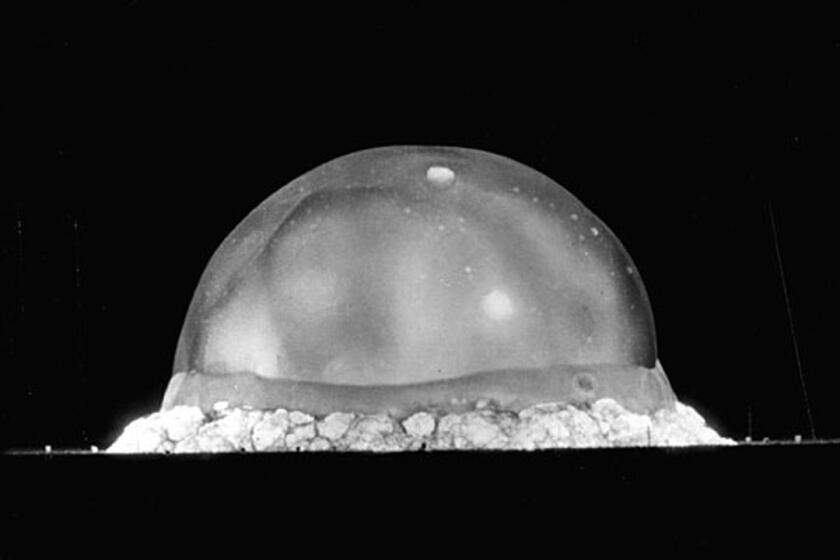The false, lethal promise of ‘warp speed’ science
- Share via
President Trump’s approach to the coronavirus pandemic has been rooted from the start in grand goals and grander ambitions, all to be achieved with record speed.
His administration’s funding of COVID-19 vaccines is dubbed “Operation Warp Speed.” As recently as Sunday, he promoted research into convalescent plasma — blood fluid taken from patients who have recovered from the virus — as “years ahead of approvals.”
He added, “If we went by the speed levels of past administration, (sic) we’d be two years, three years behind where we are today, and that includes in vaccines that you’ll be hearing about very soon, very shortly.”
In human biology often as you proceed with your research, as you think you’re getting closer and closer to the finish line, you begin to discover it’s more and more distant. You become increasingly aware of the complexity you’re dealing with.”
— Leigh Turner, University of Minnesota
Remarks like that “sends chills down everybody’s spines,” says Gregg Gonsalves, an expert on epidemiology at Yale medical school and Yale law school.
That’s because Trump’s rolling out a vaccine without adequate testing as an October surprise to aid his reelection would “set off a lot of confusion about whether it works,” generating more vaccine skepticism among the public.
Trump’s “magic bullet” approach to medicine reflects a common strain in the public’s attitude toward the scientific method — the search for uncomplicated answers for what may be complex and intractable problems, and a demand for speed when safe and effective results take time.
Trump is not alone in seeing these problems that can be quickly solved if only money and willpower are brought to bear. Before Trump’s Operation Warp Speed, there was the Obama administration’s “Cancer Moonshot,” and before that the Nixon administration’s “War on Cancer.”
Both programs did augment research funding — the Moonshot was provided with $1.8 billion over seven years and the War on Cancer (specifically, the National Cancer Act of 1971) was initially funded with $1.6 billion over three years — but obviously cancer hasn’t been cured. The main reason may be that the task was far more complicated and the target more elusive than enthusiasts anticipated.
The first element of these programs that misleads laypersons about the prospects of success is the terminology.
“Warp speed” and “moonshot” evoke programs like the Manhattan Project, which produced the atomic bomb in a mere three years, and the space race, which in 1969 fulfilled John F. Kennedy’s 1961 objective of placing a man on the moon and returning him to Earth by the end of that decade.
Both were essentially engineering challenges; there were few doubts that the challenges could be vanquished in time, given suitable infusions of funding and manpower.
Trump attacks the Food and Drug Administration and undermines its science while its leadership stays silent.
The space race occurred “in an extraordinary time with an extraordinary amount of resources put into it to achieve a finite, physical goal,” says Timothy Caulfield, an expert in health law and policy at the University of Alberta and a veteran debunker of scientific hokum. “That’s an exception to the reality of how science normally plays out.”
Biology is more complicated — perhaps infinitely so.
“In human biology often as you proceed with your research, as you think you’re getting closer and closer to the finish line, you begin to discover it’s more and more distant,” says Leigh Turner, a bioethicist at the University of Minnesota. “You become increasingly aware of the complexity you’re dealing with.”
The thirst for quick and easy solutions to difficult tasks isn’t limited to science. It’s the part of human nature that makes us susceptible to the lure of programs that promise to teach us a foreign language via software, or train us to win friends and influence people by pumping the secrets of success at us through our pillow while we sleep.
Never mind that learning a new language can take years of painstaking study and that if you don’t have charm by the time you reach adulthood, well, you’ll probably never have it.
It’s also what makes us vulnerable for anecdotal or even fraudulent claims for untested nostrums such as homeopathic remedies or stem cell treatments, especially when the curative claims are directed at desperate victims of intractable diseases.
Why wait for a treatment to undergo years of tests and trials, when an alternative is available today by mail order, bearing an endorsement from Dr. Oz or Gwyneth Paltrow?
The news media and social media are often defenseless against science hype, in part because it tends to be generated by the publicity offices of respected universities.
America has fallen so far behind in the coronavirus fight that it might lose the war permanently.
Caulfield in 2018 reported “an upswing in the use of hyperbolic discourse and spin in research publications,” with “terms such as ‘breakthrough,’ ‘game changer,’ ‘miracle,’ ‘cure,’ ‘home run’ and ‘revolutionary’ common.”
That’s often enough to prompt journalists to park their inherent skepticism to the side of the road when reporting researchers’ claims.
Indeed, several of those terms have been sprinkled through Trump’s claims for the antimalarial drug hydroxychloroquine, which has been discredited as a treatment for COVID-19 despite his assiduous promotion.
Just this weekend, Trump touted convalescent plasma as a “very historic breakthrough” in the battle against COVID-19. That captured the public’s attention, even though experts in the field tried to warn against the hyperbole.
Pressure on regulatory agencies to approve untested disease treatments or to short-circuit customary clinical trial process can be intense, especially when the need for treatment is desperate, as in the fight against COVID-19.
New drugs normally go through three rounds of trials. In Phase 1, a group of fewer than 100 healthy volunteers receives the drug to identify possible side effects. In Phase 2, a few hundred patients with the target condition are recruited for further assessment of side effects and efficacy, including possible dosing protocols.
Then comes Phase 3, in which as many as tens of thousands of subjects receive the drug to validate its effectiveness and risk in comparison with its effect on an equivalent group given a placebo, with the two groups administered the drug or placebo randomly. That’s the gold standard of clinical testing.
The problem with cutting corners in clinical trials is that the results of each phase can be deceptive.
The FDA, in a report dated January 2017 and obviously prepared before Trump’s inauguration, listed 22 cases in which new drugs were deemed promising in Phase 2 trials but failed in Phase 3.
75 years ago today, an a-bomb test in the New Mexico desert launched the nuclear age
They included 15 cases in which the drug turned out to be ineffective in treating the target disease, one in which the drug was deemed unsafe and six in which it was deemed both unsafe and ineffective. In the latter cases, the drug turned out to have side effects that hadn’t been caught in the smaller Phase 2 trials.
The report was written to caution against what the FDA termed a “growing interest in exploring alternatives to requiring Phase 3 testing before product approval.” It covered drugs that had been developed to treat heart conditions, diabetes, depression and the effects of HIV, among other ailments.
Hype has become an inextricable part of science because it can generate millions of dollars of support. Consider the 2004 campaign to pass Proposition 71, which created the $3-billion California stem cell program (known formally as the California Institute for Regenerative Medicine, or CIRM).
As I’ve reported before, the measure “was sold to a gullible public via candy-coated images of Christopher Reeve walking again and Michael J. Fox cured of Parkinson’s.”
The hype got the proposition passed, but CIRM has struggled ever since to live up to promises that it has been unable to deliver. That could be a burden this election season, when CIRM is seeking an additional $5.5 billion from voters and will have to explain why all the cures it predicted haven’t materialized.
The California Institute for Regenerative Medicine is seeking a new $5.5-billion infusion. It must go back to the drawing board.
“That still might be a worthwhile public investment,” Turner observes, adding that the research actually funded by CIRM has been conducted along responsible scientific lines. “But you have this disconnect between what’s used to float the entire enterprise, and what the actual results are.”
Biomedical “moonshots” and “wars” “are characterized as so important and promising that they should be treated differently by regulators and are sometimes tested in patients prematurely,” says Paul Knoepfler, a stem cell biologist at UC Davis who keeps a careful eye on unwarranted claims for stem cell “cures” and signs of political pressure on regulators. “In fact, such experimental therapies are often not ready for prime time.”
The siren call of easy medical fixes is both the product and the cause of our resistance to giving long-term resources to more effective programs, such as “investments in public health and preventive care,” says Gonsalves.
“We know that 55,000 jobs in public health have been lost over the past decade,” Gonsalves adds. “We’ve made long-term disinvestments in local and state public health which are coming back to bite us now. Social safety net programs have seen a slow death by a thousand cuts since the Eighties.”
Because we’re not even willing to invest in things we could afford to undertake — expanded testing, contract tracing of infected individuals, providing protective gear for healthcare personnel — “we’re grasping for magic bullets like hydroxychloroquine and convalescent plasma.”
The critical need for a remedy for COVID-19 demands more care, not more haste. What’s most troubling about the variety of hype in science today is that in this time of crisis, it’s being generated not by self-interested scientists, but self-interested politicians like Trump. Never has the need for good scientific research been more urgent, and never has it been under greater attack.
More to Read
Inside the business of entertainment
The Wide Shot brings you news, analysis and insights on everything from streaming wars to production — and what it all means for the future.
You may occasionally receive promotional content from the Los Angeles Times.















